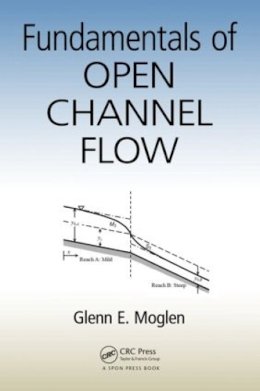Glenn Moglen is a Research Hydrologist and Research Leader for the Hydrology and Remote Sensing Laboratory (HRSL) of the Agricultural Research Service. He was formerly Professor at Virginia Tech and Director of the Occoquan Laboratory in Manassas, Virginia, USA. He has also worked as a Research Hydrologist at the National Weather Service, as an Assistant and Associate Professor at the University of Maryland, and as a Visiting Hydrologist at the U.S. Geological Survey.
"This is one of the few books that are designed exclusively for the first course on open channel flow offered in the civil engineering undergraduate curriculum... The book will be equally helpful to the student preparing for the P.E." —Journal of Hydrologic Engineering "…does an excellent job of introducing the key concepts with both physical intuition, maths that is no more complicated than is needed, and examples that students learning the material for the first time can easily engage with. …If I was teaching a first course in open channel hydraulics at the current time, this book would be high on my list of candidate texts." —Professor Garry Willgoose, The University of Newcastle, Australia "This is an excellent book and will serve undergraduate students taking the first course in hydraulics very well… will admirably succeed in stimulating students’ interest in hydraulics... will also [be] quite useful for the practicing engineer. I will recommend the book for those who want to prepare for FE and PE examinations." —Vijay P. Singh, Distinguished Professor, Texas A&M University, USA "The book provides a fresh modern take on the basic principles that underpin open channel hydraulics. It builds on the author’s experiences of teaching complex topics to entry level students. It is a useful text for first year students, providing them with easily accessible material, worked examples and links to computational tools. —Caroline Hazlewood, HR Wallingford Ltd "… a focused work presented by the author to the upcoming generation. The special feature of the book is that in a chapter, a specific phenomenon is presented starting with a physical description followed by a derivation and ending with worked out examples. All throughout the book, coherence in presentation is maintained. As a concluding remark, this book can be used effectively as a text book for undergraduate students." —Professor Subhasish Dey, Indian Institute of Technology Kharagpur, India "… specifically targeted as an introduction to open channel flow. … The presentation is very clear, thorough and easy to understand. A notable feature of the book is the use of examples, solved problems, animations and practical computational tools, such as Excel; and HEC-RAS, which help the reader to fully grasp and apply the basic concepts. Overall it is an excellent textbook for an introductory course in open channel flow." —George C. Christodoulou, National Technical U Athens "Clear and concise presentation, effective graphics, good explanation of computer solution methods." —Mark Giljum, P.E., Sanitation Districts of Los Angeles County "This is one of the few books that are designed exclusively for the first course on open channel flow offered in the civil engineering undergraduate curriculum... The book will be equally helpful to the student preparing for the P.E." —Journal of Hydrologic Engineering "…does an excellent job of introducing the key concepts with both physical intuition, maths that is no more complicated than is needed, and examples that students learning the material for the first time can easily engage with. …If I was teaching a first course in open channel hydraulics at the current time, this book would be high on my list of candidate texts." —Professor Garry Willgoose, The University of Newcastle, Australia "This is an excellent book and will serve undergraduate students taking the first course in hydraulics very well… will admirably succeed in stimulating students’ interest in hydraulics... will also [be] quite useful for the practicing engineer. I will recommend the book for those who want to prepare for FE and PE examinations." —Vijay P. Singh, Distinguished Professor, Texas A&M University, USA "The book provides a fresh modern take on the basic principles that underpin open channel hydraulics. It builds on the author’s experiences of teaching complex topics to entry level students. It is a useful text for first year students, providing them with easily accessible material, worked examples and links to computational tools. —Caroline Hazlewood, HR Wallingford Ltd "… a focused work presented by the author to the upcoming generation. The special feature of the book is that in a chapter, a specific phenomenon is presented starting with a physical description followed by a derivation and ending with worked out examples. All throughout the book, coherence in presentation is maintained. As a concluding remark, this book can be used effectively as a text book for undergraduate students." —Professor Subhasish Dey, Indian Institute of Technology Kharagpur, India "… specifically targeted as an introduction to open channel flow. … The presentation is very clear, thorough and easy to understand. A notable feature of the book is the use of examples, solved problems, animations and practical computational tools, such as Excel; and HEC-RAS, which help the reader to fully grasp and apply the basic concepts. Overall it is an excellent textbook for an introductory course in open channel flow." —George C. Christodoulou, National Technical U Athens "Clear and concise presentation, effective graphics, good explanation of computer solution methods." —Mark Giljum, P.E., Sanitation Districts of Los Angeles County

